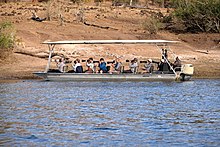
Back مراقبة الحياة البرية Arabic Observación de vida silvestre Spanish تماشای حیات وحش Persian Observation des animaux sauvages French

Wildlife observation is the practice of noting the occurrence or abundance of animal species at a specific location and time,[1] either for research purposes or recreation. Common examples of this type of activity are bird watching and whale watching.
The process of scientific wildlife observation includes the reporting of what (diagnosis of the species), where (geographical location), when (date and time), who (details about observer), and why (reason for observation, or explanations for occurrence). Wildlife observation can be performed if the animals are alive, with the most notable example being face-to-face observation and live cameras, or are dead, with the primary example being the notifying of where roadkill has occurred. This outlines the basic information needed to collect data for a wildlife observation; which can also contribute to scientific investigations of distribution, habitat relations, trends, and movement of wildlife species.
Wildlife observation allows for the study of organisms with minimal disturbance to their ecosystem depending on the type of method or equipment used. The use of equipment such as unmanned aerial vehicles (UAVs), more commonly known as drones, may disturb and cause negative impacts on wildlife.[2] Specialized equipment can be used to collect more accurate data.[3]
- ^ Davis, D. E. and R. L. Winstead, 1980. Estimating the numbers of wildlife populations. Pp. 221-247. In S.D. Schemnitz (editor). Wildlife Management and Techniques Manual. The Wildlife Society, Washington, D.C.
- ^ Hodgson, Jarrod C.; Koh, Lian Pin (2016-05-23). "Best practice for minimising unmanned aerial vehicle disturbance to wildlife in biological field research". Current Biology. 26 (10): R404–405. doi:10.1016/j.cub.2016.04.001. ISSN 1879-0445. PMID 27218843.
- ^ "605 FW 4, Wildlife Observation, Fish and Wildlife Service Manual, U.S. Fish and Wildlife Service". www.fws.gov. Retrieved 2016-09-27.